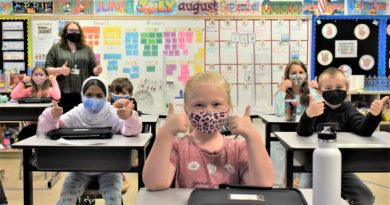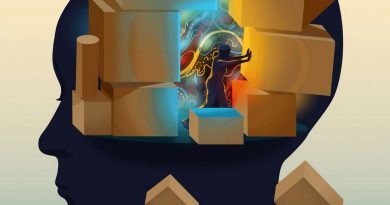Reinforcing Elementary Math Lessons With Movement
Combining simple exercises with math instruction can help ensure that elementary school students remember these lessons.
If you were to walk by my classroom at 9:01 a.m., you might see my math students out of their seats, moving their arms around and doing squats. It’s not because I’m trading in math time for aerobics. My third-grade students are warming up for their hour of math instruction.
Each move has a purpose and is integrated with the content we’re learning. Sometimes the movements act as a review; other times they’re a preview of what’s ahead. Regardless, the moves my students make are meant to help the math concepts stick.
Why Movement?
In their book The Kinesthetic Classroom, Traci Lengel and Mike Kuczala cite studies that show us how learning certain concepts through movement is efficient and long-lasting.
Movement gives learning experiences something fresh and new, which the brain likes. This novelty helps keep the attention of the students, making their learning efficient. It’s been my experience over years of using movement in math class that even those students who are timid and reluctant to participate at first are nevertheless paying attention and are interested in what’s going on around them. Their brains are still activated.
Movement, although considered an art form, is an ideal example of hands-on learning. Generally, the teacher asks students to listen and look at math examples. By adding movement, students can involve themselves with the learning in a more concrete way. The brain likes that. The more active the body is in learning, according to The Kinesthetic Classroom, the more connections the brain can make with the content.
The brain also likes repetition and practice, which forms and strengthens neural pathways in the brain, which helps concepts move more quickly from short-term to long-term memory. The key to using movement in the classroom, regardless of the subject matter, is consistency. That’s why my math students do the math moves every day.
Practice Math Vocabulary With Movement
So much of math instruction is learning and mastering vocabulary. Parallel lines, isosceles triangle, rotations, 180 degrees: Students can learn all of these terms and more through movement. Here’s an example warm-up sequence we do to get ready for math class.
First, my students start with what we call “isosceles triangle,” or “mountain” in yoga terminology: We spread our feet about two feet apart, firmly planted on the floor. Then, we take a moment to trace the three sides of the triangle with our hands. We start at the top point (our belly button) and move down one side, across the base, and up the third side.
Then it’s time for some butterfly “symmetry” breaths. While we move our arms out and up, we notice what about our body makes us symmetrical. After the second deep breath in, we pause with our hands over our head and stretch to one side, becoming asymmetrical, and then to the other side before bringing our arms back down.
Next is a shoulder stretch. We move one arm straight out in front of us and across our body. Then, with our other arm we bend our elbow and make a perpendicular intersection with our forearms. I look around and see who needs a little adjustment, telling the students that paying attention to precision is an important part of math.
Then I ask, “What are some other ways to describe our arms?”
- “Right angle.”
- “Square corner.”
- “90 degrees.”
As this becomes routine day after day, the students recognize the terms and say them with me. We often add more movement, depending on what we’re learning or what our bodies need.
If the kids are having a hard time with parallel versus perpendicular, we’ll run through a series of arm movements to show the difference. If they have a little extra energy, we get it out with some 180 degree jumps (followed by a few more symmetry breaths to get back to calm).
Moving Past Vocabulary Into Content
Not only can you practice math vocabulary with movement, but also you can reinforce content learning. My favorite activity to practice with my third-grade students is skip counting as a way to prepare for multiplication.
Students come to my classroom knowing how to skip count by 2s, 5s, and 10s, but just as important and helpful is being able to skip count by other numbers as well. I love focusing on 4s and 6s.
For the 4s, we hold four fingers up in both hands and then do slow, controlled “high knees,” bringing one knee at a time up to touch our four fingers: “4, 8, 12, 16 . . . ,” all the way up to 48.
Then, it’s time for the 6s squats. As we squat down, we count by 6: “6, 12, 18 . . . ,” holding up fingers to show which multiple we are on, all the way to 72.
Giving students this additional, whole-body experience to practice these facts using movement and rhythm has truly helped the kids memorize them.
In addition, students learn how to correctly move with a simple dance sequence involving a side step and a jump, chanting, “Over, and up! Over, and up!”
And we ease any confusion between area and perimeter when we chant the two words in rhythm while moving our hands to show the space that area covers versus drawing the perimeter with our fingertips.
The Social and Emotional Connection
There’s a huge social and emotional benefit to this five-minute whole-body math warm-up as well. With these math moves, students are able to wake up their minds, get their jitters out, and prepare their bodies for calm and focused work.
Also, teachers are always looking for ways to build community in the classroom, and movement can certainly do that. As students get up, move, and interact with the content, they’re doing something together. Activity and interaction within the classroom create a unique community.
Do all kids participate all the time? No. This is an important aspect to consider when teaching through the lens of social and emotional learning, or in this case, social-emotional artistic learning. Instead, the emphasis is on encouraging students to participate at their level of comfort and physical ability. Sometimes this means that students will remain sitting; other times they may just look on.
With consistency, all students find ways to participate in the movements, which brings a new sense of joy to the classroom. The smiles, the smirks, and the laughs all help the students learn to stick and add a positive vibe to the classroom.
Source: https://www.edutopia.org/article/reinforcing-elementary-math-lessons-movement



